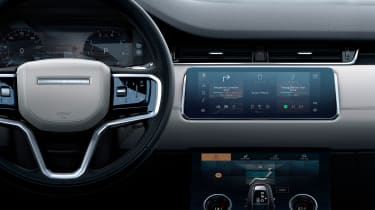Revised engines and technology for Range Rover Evoque
Range Rover Evoque SUV benefits from upgrades to diesel engines and infotainment system
- Arrival of mild-hybrid diesels
- Pivi and Pivi Pro infotainment systems arrive
- Improved convenience and wellbeing tech
The Range Rover Evoque is set to receive new diesel engines, an improved infotainment setup and a new cabin filter that can make the air cleaner inside the car. On sale now, the updated Evoque starts at £32,100, climbing to £55,580 for the lavish R-Dynamic HSE trim. A new Autobiography trim will become the Evoque flagship.
Both versions of the 2.0-litre diesel engine have been improved by losing 2kg of weight and gaining mild-hybrid tech. These steps should make it more refined and more efficient, with lower running costs.
2020 Range Rover Evoque engines and Autobiography trim
The 161bhp version of the 2.0-litre diesel can return up to 44.1mpg, while a 201bhp version manages 43.8mpg. Both are fitted with the same nine-speed automatic gearbox and four-wheel drive as standard, and produce an identical 139g/km of CO2 emissions.
A plug-in hybrid is also offered, badged P300e, and is fitted with a 1.5-litre turbo petrol three-cylinder engine, a rear-mounted electric motor and a 15kWh battery pack. It has a total output of 305bhp, giving it a brisk 0-62mph sprint time of 6.4 seconds.
Even more crucially, the P300e can return up to 201.8mpg on the WLTP efficiency test, with an electric range of up to 40 miles. This makes it the most efficient Range Rover sold to date.
The Evoque will also be available with a four-cylinder, 2.0-litre petrol engine equipped with mild-hybrid technology. It comes with 197bhp, 246bhp or 296bhp, and a nine-speed automatic transmission and four-wheel drive as standard. Despite the difference in performance, fuel economy is rated at around 31mpg for all three.
A new Autobiography trim will be available across D200, P250, P300 and P300e models, using the R-Dynamic HSE as its basis but adding Black Pack exterior trim, burnished copper accents and copper Range Rover lettering. Its exterior is finished off with 21-inch alloy wheels, Autobiography badges and Matrix LED headlights.
Inside, there's Windsor leather upholstery and a Grey Ash veneer wooden trim. A panoramic roof is fitted, along with a new electrically adjustable and heated steering wheel, 14-way heated and cooled memory front seats, and heated rear seats.
Updated technology
The big news inside is the move away from the dated Touch Pro infotainment setup to Jaguar Land Rover's Pivi and Pivi Pro setup, first seen in the new Land Rover Defender. While the display looks the same, the software and user interface are new, with fewer steps that cut screen presses by around 50%, according to Land Rover. Up to seven USB-C sockets will be available dotted around the car, offering faster charging for portable devices.
The sat nav has also been given an upgrade, so it can now learn the driver's preferred routes, calculate directions more quickly and update wirelessly at night, when the car is parked and locked. Updates can affect more than just the infotainment setup too, keeping its control systems up to date without needing to visit a dealership.
Driver aids have been supplemented with a rear collision monitor that can stop the Evoque automatically, and a bird's eye camera view that can be used at up to 19mph. This can be used both in urban settings like car parks and when negotiating tricky off-road obstacles.
A new cabin filtration system can also remove particles, bacteria and pollen to 2.5 microns in size from the interior, making the air cleaner and safer for occupants. It uses an active carbon filter and an air ionisation system to electrically charge and remove particulates.
Read our in-depth review of the Range Rover Evoque, along with rivals including the Porsche Macan and Mercedes GLA.
Most Popular
Tips & advice

Car dashboard warning lights: what does each symbol mean?

Electric car charging stations: public networks, charger types, apps and maps











